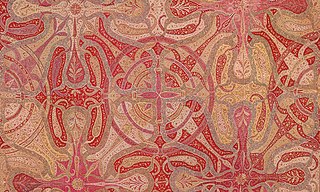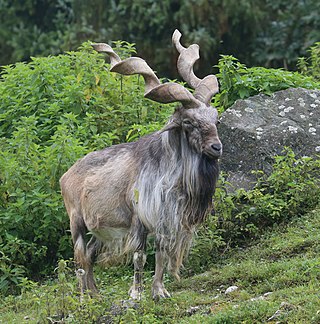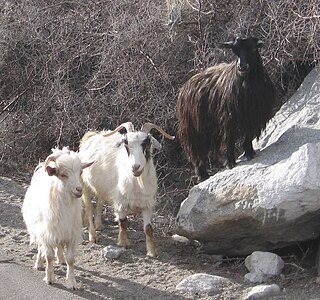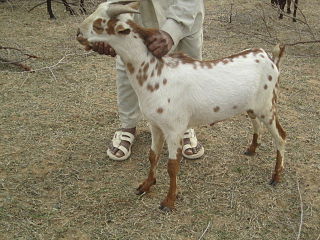Related Research Articles

The Angora or Ankara is a Turkish breed of domesticated goat. It produces the lustrous fibre known as mohair. It is widespread in many countries of the world. Many breeds derive from it, among them the Indian Mohair, the Soviet Mohair, the Angora-Don of the Russian Federation and the Pygora in the United States.

Cashmere wool, usually simply known as cashmere, is a fiber obtained from cashmere goats, pashmina goats, and some other breeds of goat. It has been used to make yarn, textiles and clothing for hundreds of years. Cashmere is closely associated with the Kashmir shawl, the word "cashmere" deriving from an anglicization of Kashmir, when the Kashmir shawl reached Europe in the 19th century. Both the soft undercoat and the guard hairs may be used; the softer hair is reserved for textiles, while the coarse guard hair is used for brushes and other non-apparel purposes. Cashmere is a hygroscopic fiber, absorbing and releasing water from the air based on the surrounding environment. This helps regulate the body in both warm and cool temperatures.

A goatherd or goatherder is a person who herds goats as a vocational activity. It is similar to a shepherd who herds sheep. Goatherds are most commonly found in regions where goat populations are significant; for instance, in Africa and South Asia. Goats are typically bred as dairy or meat animals, with some breeds being shorn for wool. The top six goat industry groups in the United States include: meat, dairy, fiber or hair, 4-H, industrial, and biotech.

Pashmina refers to, depending on the source, the cashmere wool of the Changthangi cashmere goat, fine Kashmiri cashmere wool, or any cashmere wool.

The markhor is a large wild Capra (goat) species native to South Asia and Central Asia, mainly within Pakistan, the Karakoram range, parts of Afghanistan, and the Himalayas. It is listed on the IUCN Red List as Near Threatened since 2015.

A cashmere goat is a type of goat that produces cashmere wool, the goat's fine, soft, downy, winter undercoat, in commercial quality and quantity. This undercoat grows as the days get shorter and is associated with an outer coat of coarse hair, which is present all the year and is called guard hair. Most common goat breeds, including dairy goats, grow this two-coated fleece.

Babusar Pass or Babusar Region is a mountain pass in Pakistan at the north of the 150 km long Kaghan Valley, connecting it via the Thak Nala with Chilas on the Karakoram Highway (KKH). Babusar Top is the highest point in Kaghan Valley that can be easily accessed by cars.

The Spanish goat, also called the brush goat or scrub goat, came originally from Spain via Mexico to the United States. It is now a meat and brush-clearing type found widely in the United States. In the Southeast and elsewhere, they are often referred to as "wood" (Florida), "brush" or "briar", "hill" (Virginia), and "scrub" goats. Until recently, these goats were kept mainly for clearing brush and other undesirable plant species from pasture lands. The boer goat had overtaken Spanish goats for meat by the 1980s.

The Changthangi or Changpa is a breed of cashmere goat native to the high plateaus of Ladakh in northern India. It is closely associated with the nomadic Changpa people of the Changthang plateau. It may also be known as the Ladakh Pashmina or Kashmiri.

The goat or domestic goat is a species of goat-antelope that is mostly kept as livestock. It was domesticated from the wild goat of Southwest Asia and Eastern Europe. The goat is a member of the family Bovidae, meaning it is closely related to the sheep. It was one of the first animals to be domesticated, in Iran around 10,000 years ago.
The Altai Mountain goat is a breed of domestic goat bred for wool production in the Altai Republic of the Russian Federation. The breed was developed during the years from 1944 to 1982 in the Gorno-Altai Autonomous Soviet Socialist Republic region of the Soviet Union, by cross-breeding the Don goat with local goats for a high wool yield.

The Barbari or Bari is a breed of small domestic goat found in a wide area in India and Pakistan. It is distributed in the states of Haryana, Punjab and Uttar Pradesh in India, and in Punjab and Sindh provinces of Pakistan.
The Chigu goat breed, found north of Uttar Pradesh and northeast of Himachal Pradesh in India, is used for the production of meat and cashmere wool. The coat is usually white, mixed with grayish red. Both sexes have long twisted horns. Males body weight is approximately 40 kg, while females body weight is approximately 25 kg. Conformation is similar to Chanthangi. Live in mountainous ranges with the altitude varying from 3500 to 5000 m. This area is mostly cold and arid.
Norwegian goat breeds are used for the production of milk, cheese and meat. There are two primary Norwegian goat breeds, the Norwegian milk goat and the coastal goat (kystgeit). In addition there are smaller herds of Cashmere goats, Angora goats and Boer goats.
The Zhongwei (Chung-wei) is a breed of goat from the Ningxia Hui Autonomous Region and Gansu Province of China. It lives on arid desert steppes, and is adapted to a diet of salty and sandy plants and shrubs. It is used primarily for the production of kid pelts, and secondarily for cashmere fiber. The breed has low genetic variability, likely due to the historic selection of pelt production traits. It is closely related to the Funiu White, Hexi Cashmere, Luliang Black, and Taihang breeds.
The Zhiwulin Black goat breed from the northern Shaanxi Province of China is used for the production of cashmere fiber and meat.
The Xinjiang goat breed from the mountains of Xinjiang in China is used for the production of milk, cashmere, and meat.

The Icelandic goat, also known as the 'settlement goat', is an ancient breed of domestic goat believed to be of Norwegian origin and dating back to the settlement of Iceland over 1100 years ago. This breed of goat was on the verge of extinction during the late 19th century, but recovered prior to World War II, only to precipitously decline again. The population has dropped below 100 animals several times, leading to genetic bottleneck. As of 2003, there were 348 goats in 48 flocks distributed throughout most parts of Iceland. At the end of 2012, the herd had increased to 849. Since this breed has been isolated for centuries, the Icelandic populations are highly inbred. The Icelandic goat is very rare outside its native land. Under its coarse, long guard hair, the Icelandic goat has a coat of high quality cashmere fiber. Icelandic goats are kept mainly as pets and their economic potential for meat, milk, cashmere and skin production remains to be explored. The Icelandic goat is currently of little economic value.
Kaghani may refer to:
References
- ↑ Kaghani Goat, Breeds of Livestock, Department of Animal Science, Oklahoma State University, retrieved 18 December 2008.
- ↑ Rout, Pramod Kumar; Kumar, Ashok; Behera, Basanta Kumara (21 December 2019). Goat Production and Supply Chain Management in the Tropics. CABI. p. 47. ISBN 978-1-78924-013-9.
- ↑ "Pakistan Meat - International Food & Agriculture Exhibition". agro.tdap.gov.pk. Trade Development Authority of Pakistan . Retrieved 21 December 2024.